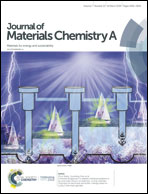A benzo[1,2-d:4,5-d′]bisthiazole-based wide-bandgap copolymer semiconductor for efficient fullerene-free organic solar cells with a small energy loss of 0.50 eV†
Abstract
With the development of narrow-bandgap small-molecule acceptors, design of wide-bandgap donors, which have complementary absorption with acceptors, becomes increasingly important. Herein, a wide-bandgap D–A-type conjugated copolymer donor, BBTA, with a benzo[1,2-d:4,5-d′]bisthiazole core as an acceptor moiety and benzo[1,2-b:4,5-b′]dithiophene as a donor moiety is designed and synthesized. Bulk-heterojunction non-fullerene OSCs based on BBTA are fabricated, achieving a PCE of 11.08% with a Voc of 1.00 V, a Jsc of 17.63 mA cm−2, a FF of 63.1% and a very low energy loss of 0.50 eV. Compared with their thiazolothiazole-based analogue, BBTA-based devices show a stronger photo-response, more balanced hole/electron mobilities, weaker bimolecular recombination and well donor/acceptor miscibility. This study reveals great potential to construct a high-performance WBG polymer donor using electron-deficient benzo[1,2-d:4,5-d′]bisthiazole.
![Graphical abstract: A benzo[1,2-d:4,5-d′]bisthiazole-based wide-bandgap copolymer semiconductor for efficient fullerene-free organic solar cells with a small energy loss of 0.50 eV](/en/Image/Get?imageInfo.ImageType=GA&imageInfo.ImageIdentifier.ManuscriptID=C8TA11492G&imageInfo.ImageIdentifier.Year=2019)


 Please wait while we load your content...
Please wait while we load your content...